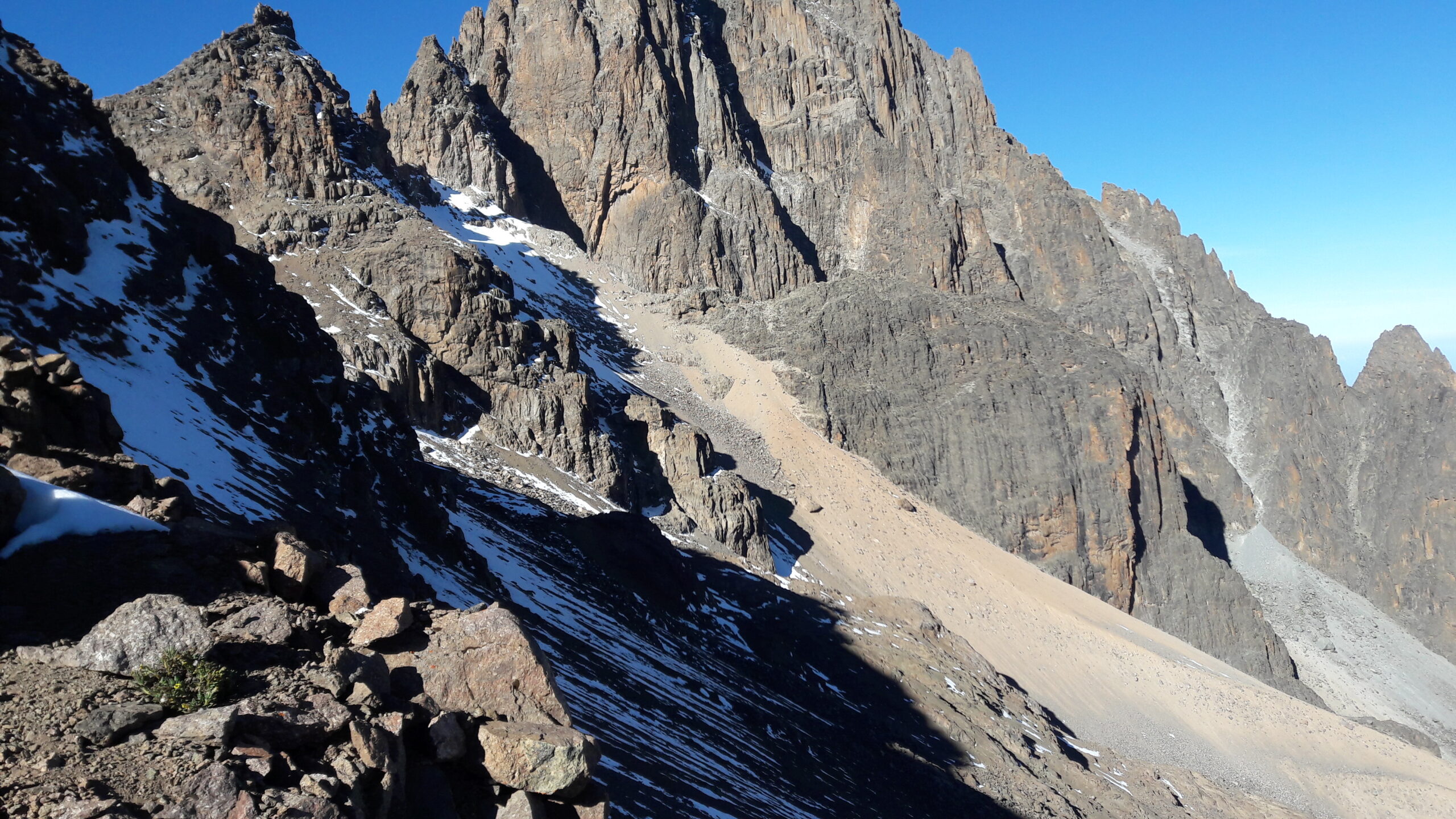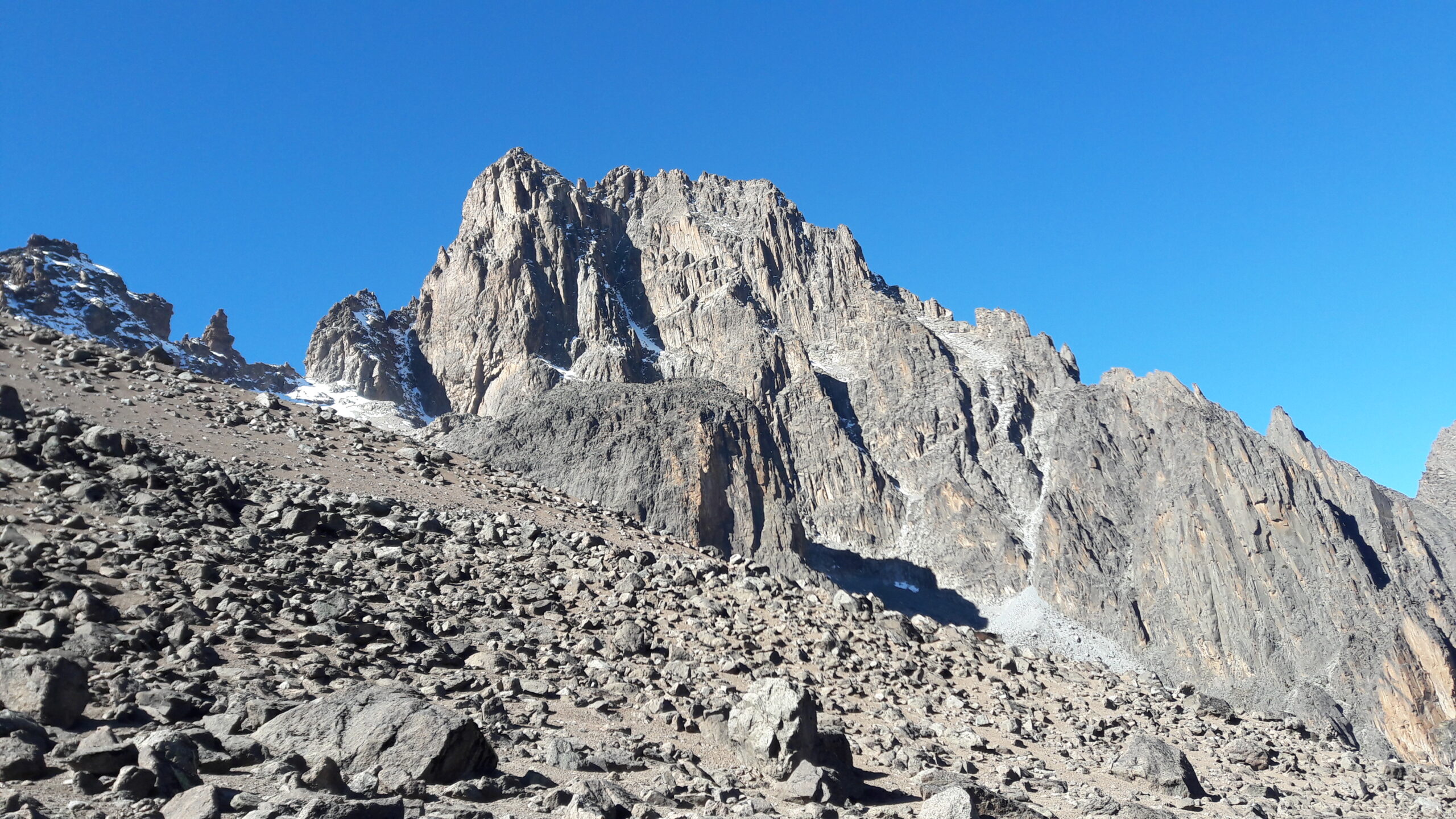Batian Peak, standing at 5,199 meters (17,057 feet), is the highest point on Mount Kenya and the second-highest in Africa after Kilimanjaro. It offers a thrilling and challenging climb, primarily suited for experienced mountaineers due to its technical nature. The peak is a significant attraction for adventurers seeking an exhilarating rock-climbing experience combined with the stunning beauty of Mount Kenya National Park.
The Route to Batian
The most popular route to Batian is via the North Face Standard Route, which requires technical rock-climbing skills. Here’s a step-by-step breakdown of the journey:
- Naro Moru or Sirimon Gate: The trek starts at the park gates, located at approximately 2,600 meters. Climbers trek through lush forests and moorlands to the base camps.
- Base Camp (Shipton’s Camp): Situated at 4,200 meters, Shipton’s Camp serves as the launching point for summiting Batian. Climbers acclimatize here to minimize altitude sickness.
- Technical Climbing: From Shipton’s Camp, climbers proceed to the Lewis Glacier before beginning the technical ascent. The North Face involves pitches of grade IV and V climbing. A guide is essential for navigation and safety.
- Summit Push: The final ascent involves challenging sections, including steep walls and narrow ridges, but rewards climbers with breathtaking views of the surrounding peaks and landscapes.
Required Skills and Equipment
- Technical Skills: Familiarity with multi-pitch rock climbing, belaying, and rope handling is critical.
- Equipment: Helmet, harness, climbing shoes, carabiners, ropes, crampons, and an ice axe for glacier navigation.
- Physical Fitness: Excellent stamina and strength are mandatory to endure the steep climb and high altitude.
Health Considerations
- Altitude Sickness: At 5,199 meters, the risk of acute mountain sickness (AMS) is high. Proper acclimatization and hydration are crucial.
- Cold Exposure: Temperatures near the summit can drop below freezing. Wear layered, insulated clothing.
- Physical Preparation: Regular cardiovascular and strength training is essential for preparation.
Climbing Mt. Kenya: Nelion Peak
Overview
Nelion Peak, standing at 5,188 meters (17,021 feet), is the second-highest peak on Mount Kenya. Known for its rugged beauty and technical challenges, Nelion offers an equally thrilling alternative to Batian. It is often climbed in conjunction with Batian by traversing the Gate of the Mists, a narrow ridge connecting the two peaks.
The Route to Nelion
The South-East Face Route is the preferred path to Nelion:
- Starting Point: Begin at the Naro Moru or Sirimon Gate and trek to Austrian Hut at 4,790 meters. Austrian Hut serves as a base for the climb.
- South-East Face Climb: This 18-pitch route involves technical rock climbing with grades ranging from IV to V. The ascent requires skillful navigation and ropework.
- Gate of the Mists (Optional): Climbers aiming for both peaks cross the icy Gate of the Mists to reach Batian. This traverse adds complexity and demands experience with mixed climbing techniques.
Required Skills and Equipment
- Technical Skills: Proficiency in traditional climbing techniques, anchor placement, and abseiling.
- Equipment: Similar to Batian, including helmets, ropes, climbing hardware, and protective clothing.
- Guides: A certified guide is recommended for safety and route management.
Health Considerations
- Acclimatization: Spend adequate time at Austrian Hut or Shipton’s Camp to adjust to the altitude.
- Injuries: Nelion’s rough terrain poses risks of sprains or falls. Proper climbing techniques reduce the chance of injury.
- Nutrition: Consume high-energy foods and stay hydrated throughout the trek and climb.
Climbing Mt. Kenya: Point Lenana
Overview
Point Lenana, at 4,985 meters (16,354 feet), is the third-highest peak on Mount Kenya and the most accessible of the three. Unlike Batian and Nelion, Point Lenana does not require technical climbing skills, making it ideal for trekkers and first-time climbers.
The Route to Point Lenana
Several routes lead to Point Lenana, with the Chogoria Route being the most scenic:
- Chogoria Gate: At 3,000 meters, the trek begins through lush forests, waterfalls, and moorlands.
- Lake Ellis and Lake Michaelson: Trekkers pass these beautiful alpine lakes before reaching Mintos Hut at 4,200 meters, a common overnight stop.
- Summit Attempt: From Mintos Hut, climbers embark on the pre-dawn push to Point Lenana. The final stretch involves steep scree slopes but does not require climbing gear.
Health Considerations
- Altitude Sickness: Symptoms like headache, nausea, and fatigue are common. Trek slowly and allow time for acclimatization.
- Cold Temperatures: The pre-dawn trek can be freezing; bring thermal layers and gloves.
- Hydration and Nutrition: Drink plenty of water and eat energy-rich foods to maintain strength.
Key Highlights
- Accessibility: Suitable for trekkers of moderate fitness levels.
- Views: Enjoy panoramic vistas of the surrounding peaks, valleys, and even Mount Kilimanjaro on clear days.
- Wildlife: Spot unique flora and fauna, including giant lobelias and hyraxes.
Final Tips for Climbing Mt. Kenya
- Plan Ahead: Book guides, porters, and permits in advance.
- Weather Awareness: The best months for climbing are January-February and July-September due to favorable weather.
- Leave No Trace: Respect the environment by minimizing your ecological impact.
Climbing Mt. Kenya is a rewarding adventure, whether you aim for the technical heights of Batian and Nelion or the trekking-friendly Point Lenana. Choose your peak, prepare thoroughly, and embrace the experience of a lifetime!




